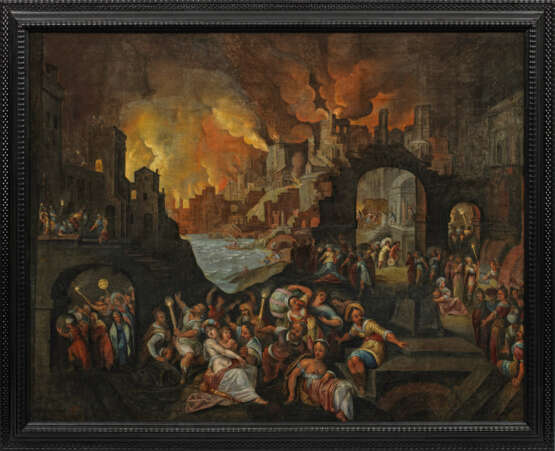ID 942273
Lot 1655 | Frederik und Gillis van Valckenborch
Estimate value
€ 12 500 – 25 000
(1565/66 Antwerpen - 1623 Nürnberg bzw. 1570 Antwerpen - 1622 Frankfurt/Main) Umkreis
Der Brand Trojas
Großformatige, höchst dramatische und effektvolle Schilderung des Untergangs von Troja mit der brennenden, nächtlichen Stadt, aus der sich die Menschen zu retten versuchen. Das vorliegende Gemälde lässt sich in Motiv und seinem spätmanieristischen Stil dem Umkreis der beiden flämischen Malerbrüder Frederik und Gillis van Valckenborch zuschreiben, die beide den größten Teil ihres Lebens in Deutschland verbrachten. Sie stammten aus einer Malerfamilie und lernten bei Ihrem Vater Marten van Valckenborch (1534 - 1612) bzw. Gillis auch bei seinem älteren Bruder Frederik; alle drei gingen 1586 in das religiös liberalere Frankfurt am Main. Dort etablierte sich die Malerfamilie rasch als führende Kraft in der Kunst und übte einen wichtigen Einfluss auf die künstlerische Entwicklung aus. Frederik und Gillis van Valckenborch malten in der Tradition von Jan Brueghel dem Älteren mit Vorliebe figurenreich verdichtete, biblische und mythologische Szenen sowie in Landschaften gesetzte Protagonisten der griechischen und römischen Geschichte, darunter Darstellungen des Brandes von Troja sowie von Aeneas bei der Rettung seines Vaters Anchises aus Troja. Während Frederik van Valckenborch 1601 nach Nürnberg zog, blieb Gillis zeitlebens in Frankfurt. In den Motiven und im Stil verwandt sind die Werke des Frankenthaler Malers Peter (Pieter) Schoubroeck (1570 - 1607), der ebenfalls von Jan Brueghel und wohl auch von der Malerfamilie Valckenborch beeinflusst wurde. Öl/Lwd., doubl.; 108 x 139 cm.
Provenienz: Aus dem Besitz einer Londoner Bankiersfamilie.
Circle of Frederik and Gillis van Valckenborch (1565/66 - 1623 and 1570 -1622). Oil on canvas, relined.
| Address of auction |
Kunstauktionshaus Schloss Ahlden GmbH Große Str. 1 29691 Ahlden(Aller) Germany | ||||||||||||||
|---|---|---|---|---|---|---|---|---|---|---|---|---|---|---|---|
| Preview |
| ||||||||||||||
| Phone | +49 5164 80100 | ||||||||||||||
| Buyer Premium | 25.0 | ||||||||||||||
| Conditions of purchase | Conditions of purchase | ||||||||||||||
| Business hours | Business hours
|



